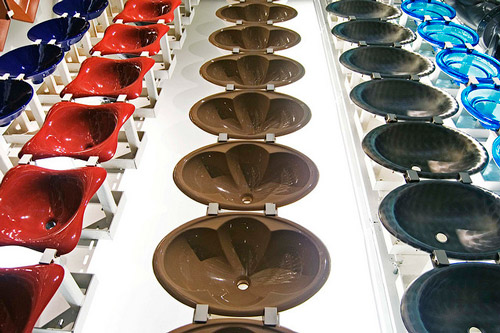If you browse the showroom prior to one of our weekly Home Renovator Auctions, you’ll discover the many, many different materials that basins can be made of. Which material is best depends on how the basin will be used. Ceramic, concrete, acrylic, marble, stainless steel and even soapstone are all used to make basins, and you never know what you’ll find at Fowles.

Acrylic for good value
Today, acrylic basins are popular because they are quite inexpensive. However, acrylic, being plastic, is susceptible to damage from hot objects, and an acrylic basic can also be impact-damaged. You often see acrylic used in ‘solid surface’ bathroom countertops, where the basin is integrated into the countertop. These have the advantage of leaving no sink-to-countertop gap that could trap dirt and germs.
Steel for specialty applications
Basins in commercial operations and in kitchens are often stainless steel. Stainless steel offers a good trade-off between cost, durability, and ease of cleaning. Stainless steel basins can be made to be very deep because the material is so strong.
Stone for pure luxury
At the high end of the price range are stone basins such as marble, granite and onyx. These have a luxurious look and are very strong. Although not as common as it once was, soapstone is also used to make basins; it has the ability to resist damage caused by caustic chemicals.
Moulded concrete for decorator applications
You would expect to find concrete basins in industrial situations, but not necessarily in homes. Increasingly popular, however, are concrete or terrazzo basins moulded into decorator shapes.
Ceramic: inexpensive and practical
Perhaps the most common material for basins is ceramic. Ceramics have been used for centuries, and the technology is one of the oldest known. A blend of clays and fillers are fused together as they are fired in an ultra-hot kiln. The product is durable, but is subject to wear and scratching over time, especially if it’s a low-fire product.
Low-fire clays are heated below 1,200° C; low-firing is often used by large commercial manufacturers, especially in developing nations. A more modern manufacturing technique heats the clay to about 1,000° C in a process known as ‘bisquing’. Then, a glaze is added, and the basin is re-fired at temperatures over 1,200° C. This melts the glaze into the clay, chemically bonding it and sealing it. The result is a very durable product that is resistant to staining, fading, heat, scratches and acidic cleaners.
Years back, most basins were made of cast iron covered in ceramic. These were heavy and chipped easily. Now, earthenware is used as a base. It is much lighter than cast iron, and there is no chance of the ceramic chipping because the cast iron is rusting. That said, ceramic does chip, and there’s nothing you can do to fix it once it has happened. Nevertheless, ceramic basins come in many colours and are inexpensive, easy to clean, long-lasting and nice looking.
